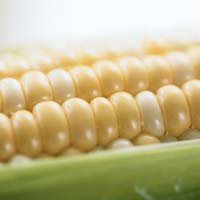Fit and Fast Recipes
Corn

Varieties
Today, the most popular varieties of corn are white (Country Gentleman) and yellow (Golden Bantam). Yellow corn has larger, buttery-flavored kernels, while white corn kernels are smaller and sweeter. Blue corn (which is literally blue) has the widest range of flavor components and is often used as an ingredient in chips.
Canned and frozen corn are widely available, and dehydrated corn is a common ingredient in trail mixes.
Everyone’s favorite movie partner, popcorn, is made from a corn variety that “pops” when exposed to dry heat, forming a featherweight, white, starchy mass many times the size of the original kernel. Most often served plain or topped with butter, popcorn is also sold topped with cheese, caramel, and other flavorings.
Indian corn has white, red, purple, brown, or multicolored kernels. It was the original corn grown by American Indians and is often used in the fall for decoration.
Tiny cobs of baby corn, often found in Thai or Chinese cooking, are sold in cans or jars. Fresh baby corn is also available and can be enjoyed either raw or cooked.
Copyright © 2025 TraceGains, Inc. All rights reserved.
Learn more about TraceGains, the company.
The information presented in the Food Guide is for informational purposes only and was created by a team of US–registered dietitians and food experts. Consult your doctor, practitioner, and/or pharmacist for any health problem and before using any supplements, making dietary changes, or before making any changes in prescribed medications. Information expires December 2025.










